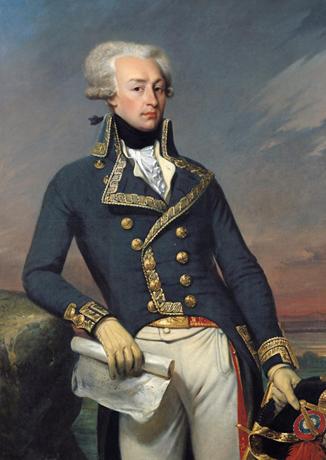When the U.S. sent its army to defend France in the First World War, General John J. Pershing presided over a Fourth of July ceremony in a private cemetery in Paris at the grave of Marie-Joseph Paul Yves Roch Gilbert du Motier, better known as the Marquis de Lafayette. To honor the memory of the remarkable Frenchman who, 140 years earlier, helped us win the Revolutionary War, Pershing’s spokesman ended his speech by saying, “Lafayette, we are here!”
Lafayette was born into an aristocratic family. When both his parents died, he became the richest orphan in France. As was the custom then, he married when he was only 16. His bride, Adrienne de Noailles, whose family was related to King Louis XVI, was 14. If history hadn’t intervened, the beautiful young couple might simply have stayed on their estate in Auvergne and lived happily ever after. But two revolutions were to change everything, and both suffering and glory lay ahead.
In 1776, Lafayette was at a dinner party when he heard about the Declaration of Independence recently issued by the American colonies. Like many young men of his time, he was much taken with the ideas of “liberty” and the “rights of man.” He described how he felt when he heard of the American uprising: “At the first news of this quarrel, my heart was enlisted.” Even though the king forbade him to go, Lafayette bought a ship and, with Baron de Kalb and a handful of soldiers, sailed for America.
Armed with a letter from the American agent in Paris, Lafayette went to General Washington, expecting to be put in charge of an army. Washington didn’t know quite what to do with the brash 19-year-old who spoke only a few words of English. But when the young man promised to work with no pay and outfit his army, Washington made him a major general. He fought bravely in many battles and spent the hard winter at Valley Forge with Washington.
When the colonials ran out of money, Lafayette sailed back to France and, dressed in an American uniform, begged King Louis to intervene in the war on the side of America. The king found the young nobleman’s argument hard to resist. Since he wanted to see the British lose, he finally agreed. The foreign minister at court declared that it was a good thing Lafayette didn’t ask for the furniture in Versailles, as “His Majesty would be unable to refuse it.” Some historians see this episode as pivotal in the downfall of Louis XVI, the move that led inexorably to the guillotine. In any case, the huge influx of soldiers and money turned the tide and helped the Americans win the revolution.
Lafayette was at the forefront of the French Revolution in 1789, offering his own version of the “rights of man.” However, as the revolution wore on and extremists took over, every aristocrat in the country was being hunted down and sent to the guillotine. Fighting for the French in Austria, Lafayette found out he was about to be arrested and fled. He was captured in Germany and spent the next five years in prison. Meanwhile, Adrienne and her relatives were sent to prison and condemned to death. The American envoy in Paris managed to save Adrienne’s life, but her mother, sister and grandmother were killed.
Adrienne sent their son, George Washington Lafayette, to America to live with his godparents at Mount Vernon. She then took their two daughters and persuaded the authorities to allow the family to live in prison with Lafayette. When Napoleon came to power and Lafayette was finally released, the family returned to France to find that much of their wealth had been confiscated. They managed to get most of it back over the years, but the hardships Adrienne had endured were too much for her and she died at the age of 47.
In 1824, Lafayette made a triumphal return trip to America. He visited each of the then 24 states and was met everywhere with wild enthusiasm and adulation. Congress voted to pay back the $200,000 they owed him for the arms and equipment he had paid for, also giving him land in Louisiana and Florida. In a grand gesture of appreciation, they named the park that stands in front of the White House “Lafayette Park.”
Lafayette returned to France with a plot of soil from Bunker Hill. When he died at the age of 77, his son made sure his father was buried in that soil. Even though Lafayette himself designed the modern French tricolor flag, it is an American flag that flies daily over his grave in a small cemetery in Paris’s 12th arrondissement. It was here, on July 4, 1917, that Pershing’s aide announced that America had arrived to pay a debt. He said, “What we have of blood and treasure are yours,” and ended his speech with a resounding “Nous voila, Lafayette!” French schoolchildren learn that phrase to this day.
Donna Evers, devers@eversco.com, is the owner and broker of Evers & Co. Real Estate, the largest woman-owned, woman-run real estate firm in the Washington metropolitan area; the proprietor of Twin Oaks Tavern Winery in Bluemont, Va.; and a devoted student of Washington-area history.


